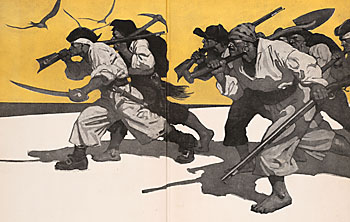 | N.C. Wyeth's illustration from Robert Louis Stevenson's "Treasure Island" (New York, 1919) is among the images of pirates featured in the Beinecke Library exhibition "The Very Picture of Transgression," on view Sept. 6-Oct. 31. |
The pirate — a figure that has captivated the public imagination for hundreds of years — is the subject of an exhibition opening on Thursday, Sept. 6, at the Beinecke
Rare Book and Manuscript Library.
T H I S
Exhibit explores fusion of fact
and fiction in pirate portrayals
In the 19th century and later, there was an explosion of art, literature and
performance works devoted to pirates. Pirates were often portrayed as exciting
adventurers who were willing to follow their dreams of buried treasure into new
territories, note the exhibit organizers. Examples of representations of
pirates in this period in the exhibition are Robert Louis Stevenson’s “Treasure Island,” Gilbert and Sullivan’s “Pirates of Penzance” and J.M. Barrie’s “Peter Pan.” Other printed documents and original art from Beinecke’s collections illustrate the evolving image of the pirate and its shifting role
in music, theatrical arts, adventure tales and reportage.
The Beinecke Library, 121 Wall St., is open for exhibition viewing 8:30 a.m.-8
p.m. Monday-Thursday; 8:30 a.m.-5 p.m. Friday; and 10 a.m.-5 p.m. Saturday. The
exhibition will remain on view through Oct. 31. The library is closed on Sept.
3 (Labor Day). For further information, call (203) 432-2972 or visit the
library’s website at www.library.yale.edu/beinecke.
 W E E K ' S
W E E K ' S S T O R I E S
S T O R I E S![]()
 University is welcoming its most diverse freshman class in history
University is welcoming its most diverse freshman class in history![]()
![]()
 Yale will bring educational treasures to iTunesU
Yale will bring educational treasures to iTunesU![]()
![]()
 Appointments Announced
Appointments Announced
 Yale College deans for student and Native American affairs
Yale College deans for student and Native American affairs![]()
 Deputy provosts for science, faculty development
Deputy provosts for science, faculty development![]()
 Coordinator of community programs in science
Coordinator of community programs in science![]()
![]()
 Yale Arab Alumni Association launched this summer
Yale Arab Alumni Association launched this summer![]()
![]()
 Yalies get taste of Hollywood as ‘Indiana Jones’ extras
Yalies get taste of Hollywood as ‘Indiana Jones’ extras![]()
![]()
 SCHOOL OF MANAGEMENT NEWS
SCHOOL OF MANAGEMENT NEWS
 Five new faculty members begin teaching this fall
Five new faculty members begin teaching this fall![]()
 Students win championship round of new game show
Students win championship round of new game show![]()
 New clinic offers free aid to local businesses, non-profits
New clinic offers free aid to local businesses, non-profits![]()
 Jeffrey Sonnenfeld cited as a business school ‘All Star’
Jeffrey Sonnenfeld cited as a business school ‘All Star’![]()
![]()
 DeVane Lectures to explore impact of performing arts
DeVane Lectures to explore impact of performing arts![]()
![]()
 Scientists discover that evolution is driven by gene regulation
Scientists discover that evolution is driven by gene regulation![]()
![]()
 Exhibit explores fusion of fact and fiction in pirate portrayals
Exhibit explores fusion of fact and fiction in pirate portrayals![]()
![]()
 Also on view at the Beinecke Library
Also on view at the Beinecke Library![]()
![]()
 Exhibit features landscapes by photographer Jem Southam
Exhibit features landscapes by photographer Jem Southam![]()
![]()
 Volunteers will again help during ‘Days of Caring’
Volunteers will again help during ‘Days of Caring’![]()
![]()
 Show celebrates East Asia collection’s 100th anniversary
Show celebrates East Asia collection’s 100th anniversary![]()
![]()
 Appointments at Center for Bioethics include a new director, David Smith
Appointments at Center for Bioethics include a new director, David Smith ![]()
![]()
 New residential college deans named
New residential college deans named![]()
![]()
 Events explore topics of reconciliation and ‘laws common to all mankind’
Events explore topics of reconciliation and ‘laws common to all mankind’![]()
![]()
 Yale Art Museums’ Open House to feature music, tours and more
Yale Art Museums’ Open House to feature music, tours and more ![]()
![]()
 Yale Library unveils blog and search tool
Yale Library unveils blog and search tool![]()
![]()
 OISS seeking hosts for its Community Friends program
OISS seeking hosts for its Community Friends program![]()
![]()
 IN MEMORIAM
IN MEMORIAM
 Letty Russell: Feminist theologian, leader in ecumenical movement
Letty Russell: Feminist theologian, leader in ecumenical movement ![]()
 Brevard S. Childs: Influential Old Testament scholar, beloved teacher
Brevard S. Childs: Influential Old Testament scholar, beloved teacher ![]()
 Memorial service to be held for astronomy researcher Dorrit Hoffleit
Memorial service to be held for astronomy researcher Dorrit Hoffleit![]()
![]()
 Campus Notes
Campus Notes![]()
Bulletin Home |
| Visiting on Campus
Visiting on Campus |
| Calendar of Events
Calendar of Events |
| In the News
In the News![]()
Bulletin Board |
| Classified Ads
Classified Ads |
| Search Archives
Search Archives |
| Deadlines
Deadlines![]()
Bulletin Staff |
| Public Affairs
Public Affairs |
| News Releases
News Releases |
| E-Mail Us
E-Mail Us |
| Yale Home
Yale Home